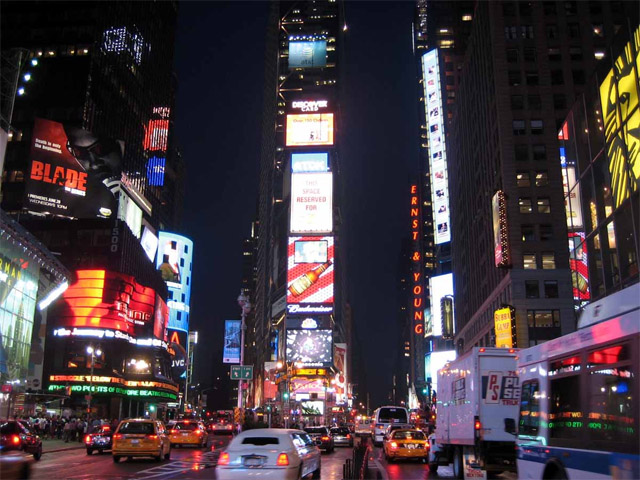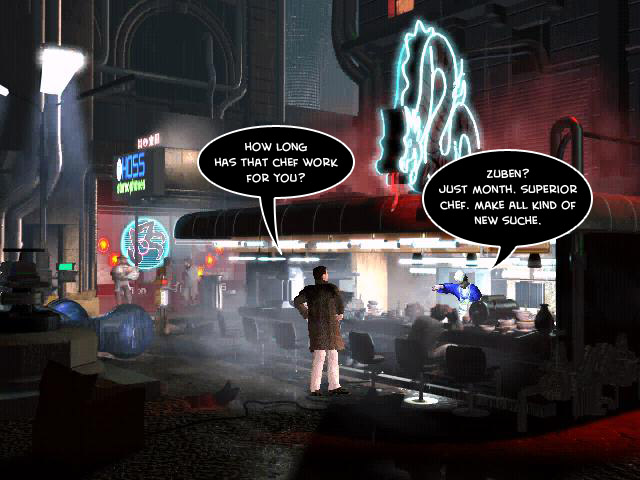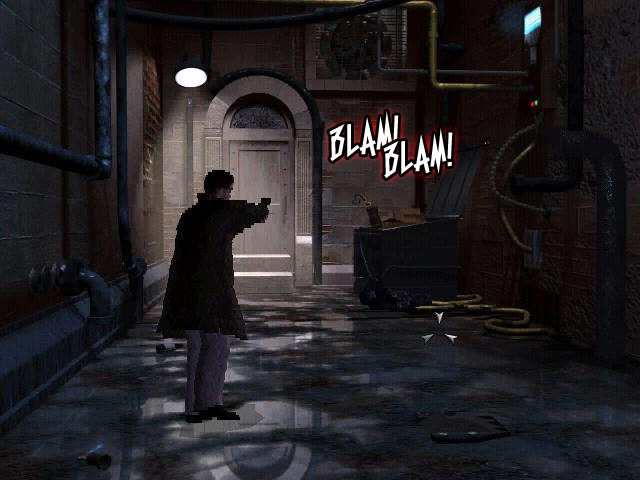Part 5: Act I - Sushi. That's What My Ex-Wife Called Me.
Act I - Sushi. That's What My Ex-Wife Called Me.
After sending all the evidence back to the lab, we're going out on the prowl looking for this girl:
Judging from the chopsticks and the menu we found on her desk, she seemed to have an affinity for a sushi place called Howie Lee's, down in Chinatown...
The blimp in the background advertises off world travel destinations.
The thing about Electric Sheep and Blade Runner was that though they were created only 14 years apart, it was two very different eras. The American 1960s were a time of the Cuban Missile Crisis, the Sputnik, the Kennedy Assassination, and the Cold War. Electric Sheep projected the future from this, so the setting in the book was far more post-apocalyptic in nature; the world had been ravaged by a nuclear war, and the United Nations had moved the majority of the human population to off world colonies. The only people left on Earth were those either too stubborn to move, or those too irradiated to reproduce.
1982 was a different era in the States. The Cold War was winding down, and looking in the future there was a new 'threat' on the horizon - Japan had rapidly recovered from WW2 and had become an economic juggernaut between the 60's and the 80's. There were rising fears of immigration, and the Blade Runner set design capitalized on a lot of this anxiety by taking a step sideways from a typical American city, fusing Asian urban design into it instead. The result was an environment that was always raining, always night, and looked nothing like Los Angeles.
The traditional standard for a brightly lit American cityscape is probably Times Square:

The North American familiarity with this scene stems from, really, the cars. North America is more car-centric in its urban areas than anywhere else, so you end up having a lot of space and gaps in between buildings. The end result is that when you're standing at ground level Time Square, you look around, and the effect is wow, the buildings are tall.
Contrast this to Tokyo at night:

Where the cars are a lot smaller and narrower, and there's a lot more emphasis on accommodating pedestrian traffic. The crush of people, the close density of the buildings, the billboards that jut out into the street; they all contribute to a vertical claustrophobia that causes you think, wow, I am small.
It's that kind of urban visual overload, more so than the Chinese language billboards I think, that emphasized the foreignness and the unease North American audiences had with the film. The fact that the film was strangely prescient about the rise of Japanese influence over the next two decades certainly didn't hurt its status as a cult film.
This is Howie Lee's - it's also where we first saw Deckard in the movie.
This asshole in the goofy looking coat is uncooperative, but the cook in the back notices us...
... and returns to the kitchen. Hmm.
We've got Lucy's photo now from the ESPER, so we can run around showing it to everyone.

Time to run waltz into the kitchen out back while Howie's not looking.
Like hot dogs and ground beef, you don't want to know where your sushi comes from.
Zuben gets spooked and tries to run for it.
Now, usually we'd get hot soya and offworld lichen spilt all over us, but if you knew this was coming, you can click madly on the right side and dive out of the way.
Diving out the way lets us chase him down faster, so we can see him running down the alley here.
Police chase time!
There's the Replicant fucker.

Wait, wasn't the chef a bigger guy than this?
No, this was just some random guy rifling through the dumpster in the alley.
We just shot and killed a hobo.
Shit.